The Ninja 400 can accelerate from 0-60 mph in 4.15 seconds
Kawasaki’s Ninja 400 was introduced in 2018 and replaced the hugely capable and popular Ninja 300 – that was itself a replacement for the Ninja 250.
The introduction of the Ninja 400 likely was Kawasaki’s response to Yamaha’s YZF-R3 among many other factors.
That machine had the edge on the Ninja 300.
It was a little more powerful courtesy of its slightly larger engine which meant that engine performance and straight-line speed was, and remains superior!
Performance matters to many, and on paper, the YZF-R3 had the edge over the Ninja 300. So Kawasaki had to respnd.
No doubt also an influencing factor that pushed Kawasaki to design a big-bore version of their Ninja 300 was primarily to accommodate the ever-evolving motorcycle learner laws.
The Ninja 400 was also a response to competitors offering faster and more powerful alternatives that were not necessary in the same class.
Kawasaki’s Ninja 400 engine was generally much the same as the 300 it replaced but got a significant capacity boost.
This capacity hike jumped from 296 cc that the Ninja 300 was endowed with, to a much beefier 399 cc for the new Ninja 400.
A 105 cc jump might not sound like a lot but for a smaller capacity motorcycle that 105 cc represents a massive 35% increase in engine size over the Ninja 300.

The Ninja 400 has a peak claimed power (dependent on the market) of 49 hp at the crank.
This is compared to the 35 hp at the crank for the Ninja 300 and is a welcome boost to Kawasaki fans and those 300 owners looking to upgrade.
That jump in power is a 40% increase which is significant, and all derived from that extra 105 cc.
Not surprisingly, torque is up 40 % over the Ninja 300 and to a claimed 28 lb/ft.
The larger engine ensured that the Ninja 400 was more tractable and is less dependent on gears and rpm to make effective overtakes compared to the Ninja 300.
Therefore, it meant that the Kawasaki Ninja 400 almost has that big bike feel courtesy of its larger engine.
The Kawasaki Ninja 300 despite being a quick little bike never had that big bike feel.
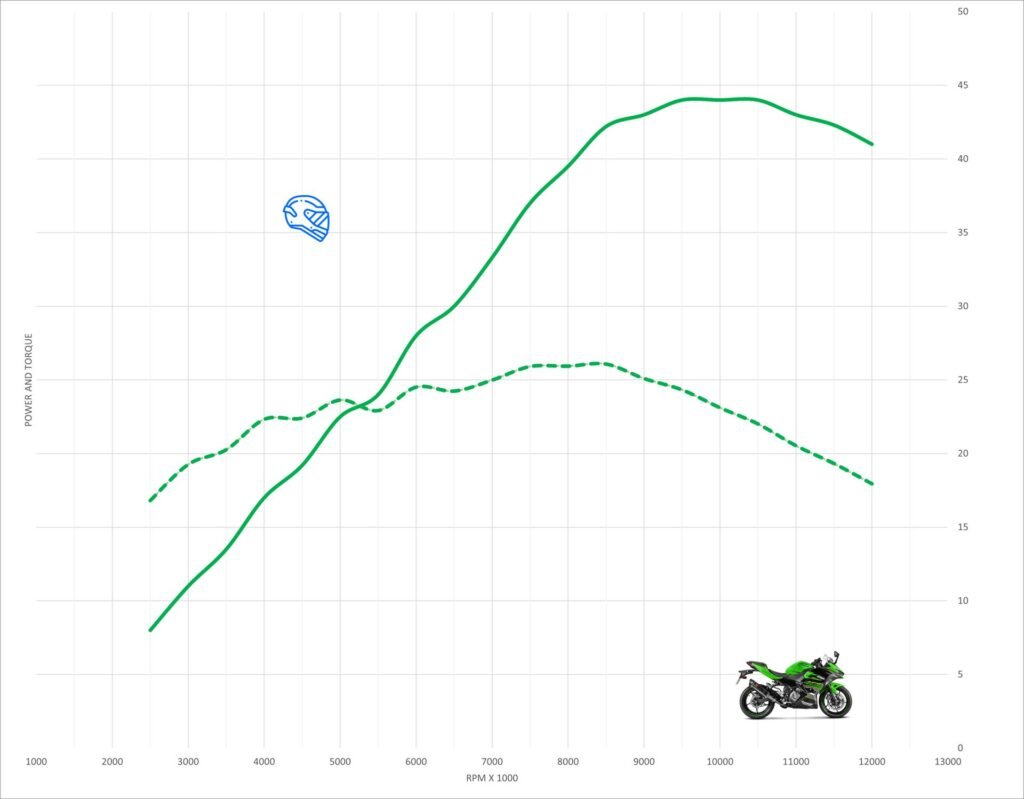
Kawasaki Ninja 400 Dyno Curve
As you can see from the above dyno curve the new Ninja 400 produces a very impressive 44 horsepower at 10,500 rpm.
This rear wheel figure is not so far off Kawasaki’s claim of 49 hp at the crank.
As a rule, when power is transferred from crank to wheel the average chain-driven motorcycle will lose around 10-12 % of its power through transmission losses.
This loss is caused by friction and heat in the engine, as well as the effort to spin the rear wheel and tyre which all contribute to power loss.
This is often why we see rear wheel horsepower figures differ from the actual manufacturer’s claims at the crank.
The Ninja 400 in terms of power sits right next to Honda’s CBR500R This is surprising if considering that the Ninja 400 has a smaller capacity engine.
it also matches up closely with KTM’s fiery little RC 390.
What is also impressive is that the little banging parallel twin produces more than 40 horsepower from 8000 rpm and carries this to 12,000 rpm.

Kawasaki Ninja 400 in-gear acceleration
That wide spread of power ensures that the Ninja 400 is not so dependent on being in the ‘right’ gear.
So a rider can still make good progress without the need to scream the engine all the way to 12,000 rpm, something that is necessary with some competitors.
Ensuring that you select the correct gear is a reality that you live with when riding the smaller Ninja 300.
While fun on occasion, constant gear changing can become hard work and tiresome, especially if trying to keep friends on faster motorcycles in sight on roads that require speeding up and slowing down often.
This wide spread of peak power also allows you to hold on to gears for a little longer in corners because there is ample drive from as low as 6000 rpm
Additionally, the engine is relatively flexible because right from 3000 rpm the Ninja 400 is making more torque than the 300 Ninja does at peak.
It also beats out the YZF-R3 too.
Despite the Ninja 400s engine punching above its weight, it’s more effective keeping the engine in the higher rpm if you want to make the fastest progress against larger motorcycles.
Ideally, rpm should be kept at no lower than 6000 rpm, though from 7000 rpm onward is the point at which the engine works very well, providing good acceleration.
Ninja 400 in gear speeds at 5000 rpm
| Speed at 5000 rpm | Ninja 400 |
| Speed 1st Gear | 18.8 mph |
| Speed 2nd Gear | 26.8 mph |
| Speed 3rd Gear | 34.1 mph |
| Speed 4th Gear | 41.4 mph |
| Speed 5th Gear | 47.8 mph |
| Speed 6th Gear | 53.2 mph |
Due to the engine size and low gear ratios, rpm will always be relatively high in most real-world situations compared to larger-capacity motorcycles.
That’s just a reality of a sub 500 cc motorcycle unless it’s a long-stroke single-cylinder engine.
For a small engine, the Kawasaki Ninja 400 is not that buzzy – for example, at 70 mph highway cruising speeds the Ninja 400 will be showing around 6600 rpm in sixth gear.
For comparison, a Yamaha YZF-R6 will show around 6400 rpm, and its little sister the Ninja 300 is quite a bit more frantic at around 7600 rpm.
You can use sixth gear at 70 mph on the Ninja 400 and overtake effectively.
Try the same while riding the Kawasaki Ninja 300 and you’d need to kick down a gear, especially in a headwind or up any kind of incline.
This meatier delivery and the less frantic engine are what ensure that the Ninja 400 feels like a ‘big bike’.
Its performance hints at this too according to the numbers it puts down.
Kawasaki Ninja 400 Top Speed and Acceleration Review
Obviously, with more power and a relatively light wet weight of 169 kg, the little Ninja 400 is pretty quick.
It’s a significant step up from the Ninja 300 which is also surprisingly a little heavier at 172 kg!
The Ninja 400 does not quite have the legs of the bigger sister Ninja 650 but it gets remarkably close considering that it gives away a whopping 250 cc.
With a close-to-perfect launch, the Ninja 400 can accelerate from 0-100 km/h in only 4.35 seconds. For the UK/US guys – that’s 0-60 mph in 4.15 seconds. Pretty wild for what is considered an entry-level sports bike,
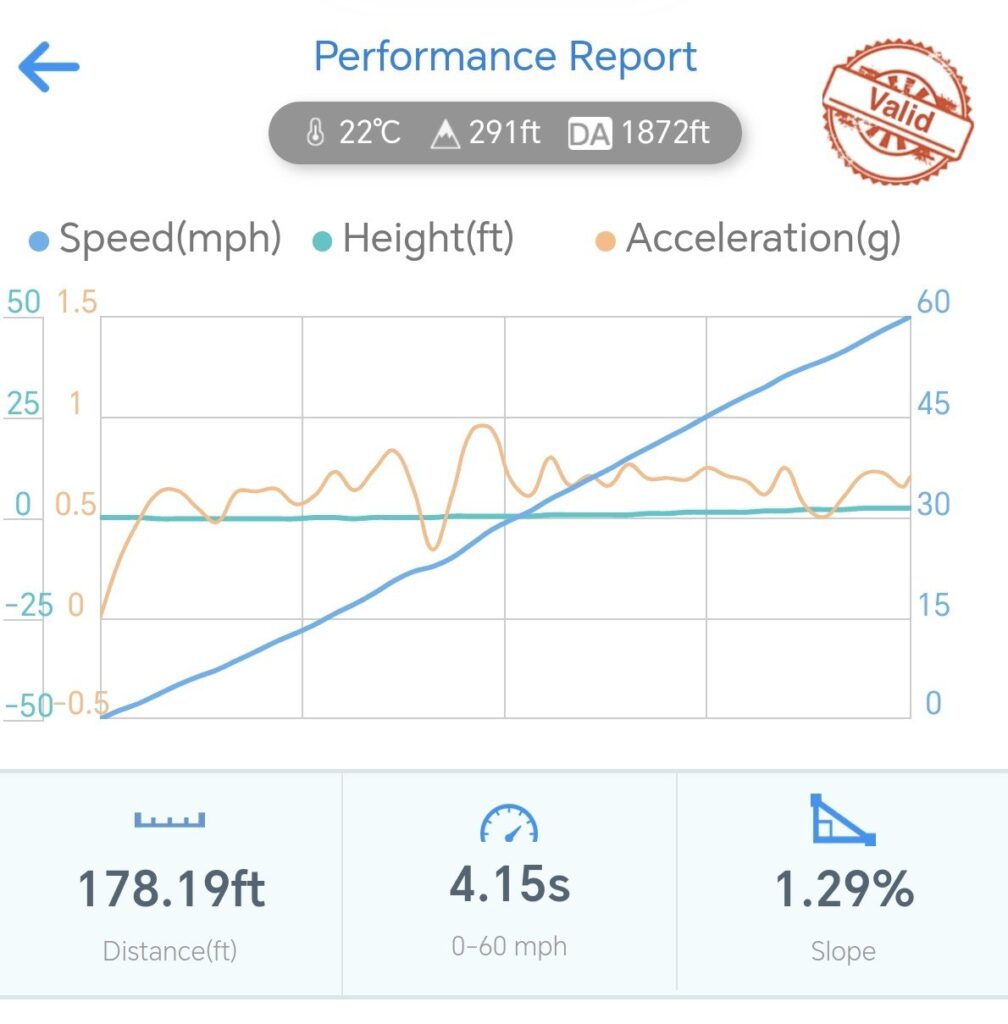
It’s still a little slower than one of its bigger capacity rivals the MT-07 and YZF-R7, though it is quite close considering the displacement disadvantage that Ninja 400 gibes away.
For anyone who is a petrolhead of any persuasion knows that a sub 5 second 0-100 km/h 0r 0-60 mph time is significantly quick at any standard.
The Kawasaki Ninja 400 is as fast, and in some cases faster than many hot hatches and sports cars past and present.
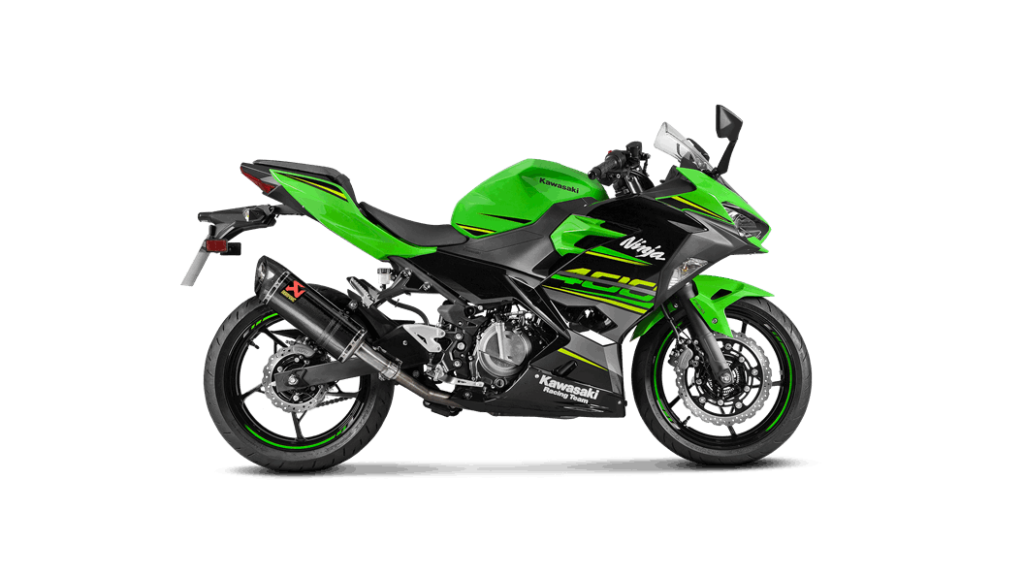
A lot of smaller capacity motorcycles in this class can all accelerate to 100 km/h in around 6 seconds or under.
The Ninja 300 chimes in at around 5.40 seconds from 0-60 mph, but as speeds increase their acceleration does start to relent more significantly due to their lack of power.
Also, it is very important to note that smaller capacity motorcycles with less than 50 horsepower, conditions play a larger role in the elapsed times and terminal speed that are achievable.
So conditions need to be perfect when testing motorcycles with modest power outputs.
With that larger engine, the Ninja 400 is still peppy above 60 mph as we can clearly see.
If we look at its acceleration from 0-100 mph we see a time of 11.8 seconds. This is faster than I’d thought the Ninja 400 was capable of.
The Kawasaki Ninja 400 is 6 seconds faster to 100 mph than its little 300 sister.
60 mph to 100 through the gears comes up in 7.75 seconds whereas the Ninja 300 lags behind significantly with a lethargic 12.80 seconds.
To put this into perspective, the Ninja 400 can get from 0-100 mph faster than the Ninja 300 can accelerate from 60 mph to 100mph.
The Ninja 400s standing start quarter mile comes up in 12.98 seconds @ 102 mph.
The terminal speed at the end of the quarter mile is slightly impacted by an inconvenient gear change at 100 mph and around 40 meters from the finish.
The Kawasaki Ninja 400 still betters one of its nearest rivals from KTM and is a fraction faster than the naked Z400 sister thanks to its full fairing.
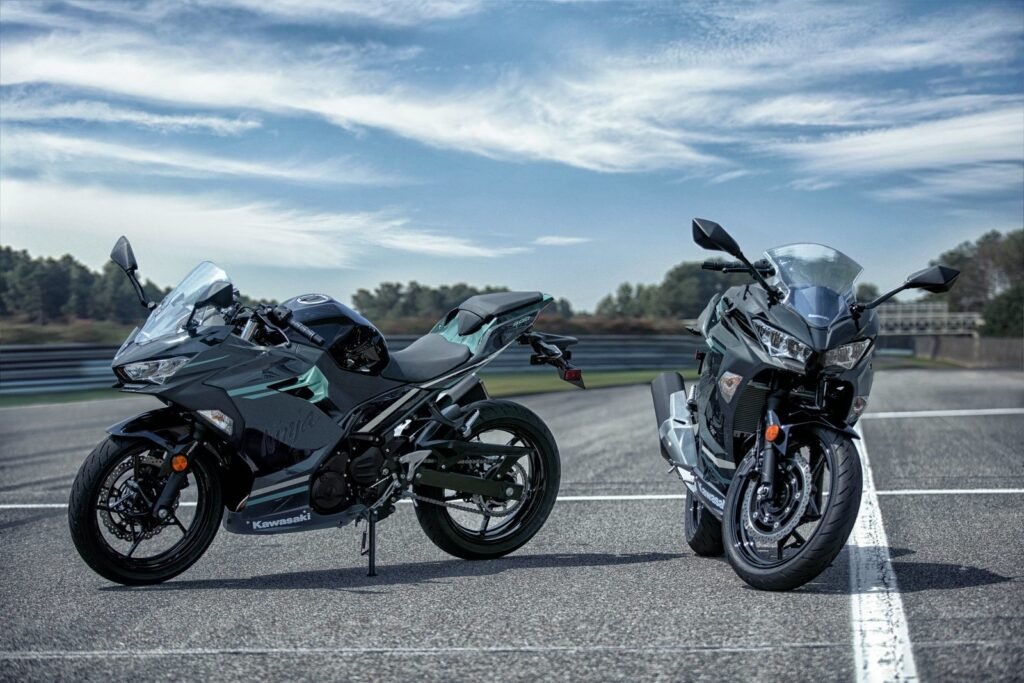
Kawasaki Ninja 400 Top Speed is 116.7mph
With all smaller capacity lower power motorcycles. Seeking out their maximum speed requires a jockey tuck and a significantly long piece of tarmac.
To reach its ultimate top speed of 116 mph (186 km/h) the Kawasaki Ninja 400 needs 100 seconds and around 4.8 km.
However, that would not be a fair analysis as the Kawasaki Ninja 400 can achieve 111 mph (180 km/h) in around 20 seconds at around 750 meters from a stop.
It is just that the last few mph require a significant amount of time and distance.
The Kawasaki Ninja 400 can achieve its top speed in fifth gear at a smudge under the redline if you stretch that gear out long enough.
Hooking 6th gear does not change anything. This is because the Ninja 400 on test couldn’t pull 6th to the redline which would be a real 129.8 mph and (209 km/h)
If we removed the mirrors and had a screen that offered better protection in a tuck we might expect an extra few mph.
Most Kawasaki Ninja 400s will get some bolt-ons to boost power and performance.
A good exhaust system, fuelling sorted, and performance filter could see the little Ninja hitting a real 124 mph (200 km/h) top speed.
Some of the race machines with bolt-on modifications are hitting 130mph which is remarkable!
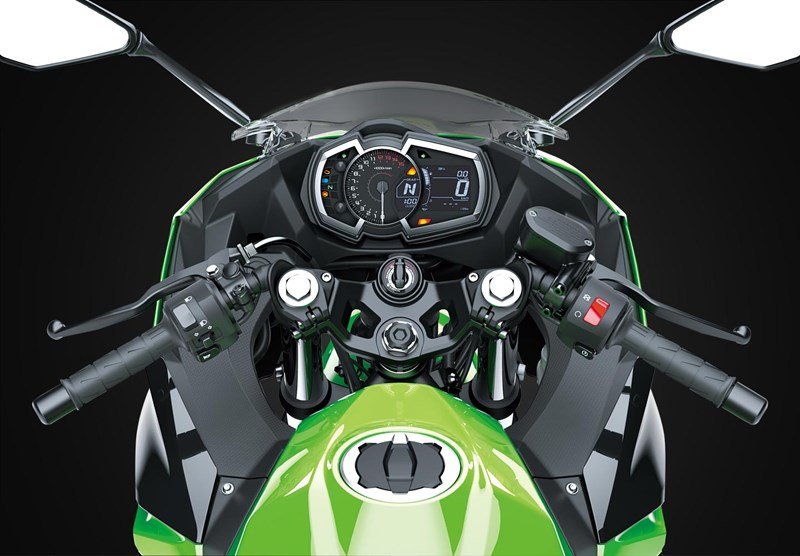
Not everyone will get top speeds and times like this due to the Ninja 400 still being a relatively low-powered motorcycle.
To achieve optimum times like this the stars really must align, and it is necessary for the rider to be light (65kg) or less and for conditions to be close to perfect.
A 10-20 kg rider weight difference plus even a moderate headwind or unfavourable conditions, will significantly hinder acceleration and top-speed ETs.
After all, the Kawasaki Ninja 400 only produces a little over 40 horsepower and thus is affected to a greater extent by varying rider weights or conditions on the day..
These variables do not impact a much more powerful motorcycle to the same extent as a sub 50 horsepower motorcycle such as the Ninja 400.
The Ninja 400 is an exceptionally good learner motorcycle, economical with cheap motorcycle insurance, while also being a very capable sportbike even for more experienced riders.
Either way, the Kawasaki Ninja 400 has good straight-line performance and is a significant step up over the Ninja 300!
But you may also be looking at other class competitors such as the YZF-R7, Honda CBR650R full power, or the restricted CBR650R and little sister CBR500R.
These are all motorcycles that can fit in the same very diverse class of entry-level sport motorcycles as the Kawasaki Ninja 400.
To make things more interesting Kawasaki has introduced the ZX-4RR to really shake up the the class. The ZX-4RR is motorcycle that offers up some more sibling rivalry for the Ninja 400.
If it already didn;t have enough from the Ninja 650 and Ninja 300.
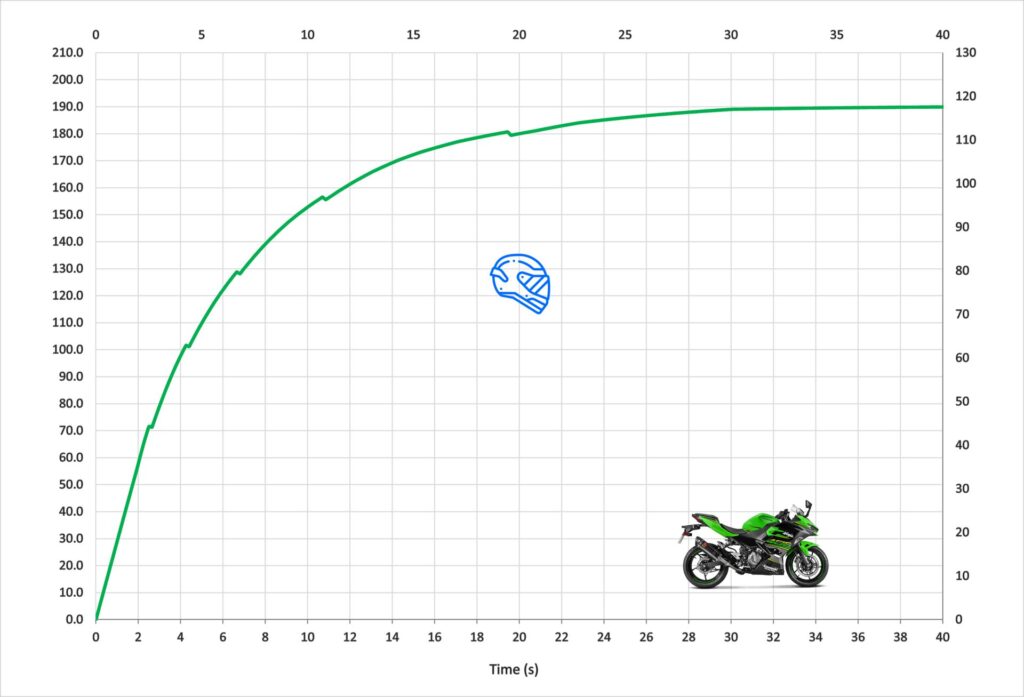
Kawasaki Ninja 400 vs Yamaha YZF-R3 HERE
| Kawasaki Ninja 400 Acceleration | |
| Speed | Time |
| 0-10 mph | 0.62 |
| 0-20 mph | 1.24 |
| 0-30 mph | 1.87 |
| 0-40 mph | 2.49 |
| 0-50 mph | 3.28 |
| 0-60 mph | 4.15 |
| 0-70 mph | 5.39 |
| 0-80 mph | 6.83 |
| 0-90 mph | 8.93 |
| 0-100 mph | 11.90 |
| 0-110 mph | 17.51 |
| SS/QM | 12.98/102 mph |
| SS/KM | 25.12/114 mph |
| SS/Mile | 36.73/115 mph |
| Top Speed | 116.7 mph |
Kawasaki Ninja 400 Specifications
| Kawasaki Ninja 400 | |
| Engine | |
| Engine type | 4-stroke, 2-cylinder, DOHC, liquid-cooled |
| Capacity | 399 cc |
| Bore x stroke | 70.0 x 51.8mm |
| Compression ratio | 11.5:1 |
| Maximum power | 49 HP 10500 RPM |
| Maximum torque | 28.0 lb-ft @ 8,000 rpm |
| Lubrication system | Wet sump |
| Clutch type | Slipper and self-servo wet multiplate clutch with hydraulic control |
| Ignition system | Digital Advance |
| Starter system | Electric |
| Transmission system | Constant Mesh, 6-speed |
| Final transmission | Chain |
| Chassis | |
| Frame | Semi-double cradle, high-tensile steel |
| Front suspension system | 41mm Telescopic fork/4.7 in |
| Rear suspension system | Bottom-link Uni-Trak®, swingarm adjustable preload/5.1 in |
| Front brake | 310mm semi-floating single disc |
| Rear brake | 220mm single disc |
| Front tyre | 110/70×17 |
| Rear tyre | 150/70×17 |
| Dimensions | |
| Wheelbase | 1,370 mm |
| Wet weight (including full oil and fuel tank | 168 kg |
| Fuel tank capacity | 14 litres |











